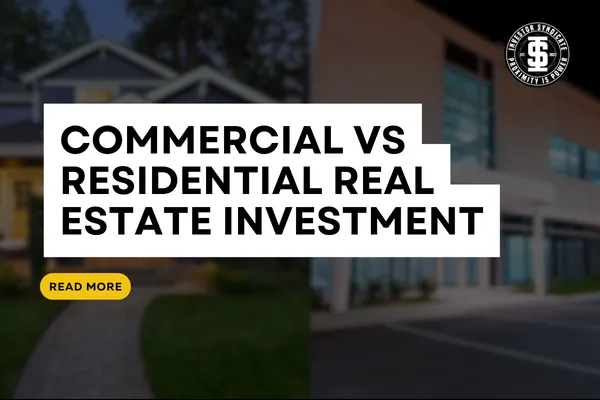Investor Syndicate Blogs
Download The Deal Flipping Playbook

Commercial vs Residential Real Estate Investment
Introduction
Investing in real estate can be a rewarding venture, offering the potential for long-term financial stability and growth. However, when it comes to real estate investment, one of the fundamental decisions investors face is whether to invest in commercial or residential properties. Each type of investment has its unique characteristics, benefits, and considerations.

Commercial Real Estate Investment
Commercial real estate investment entails purchasing properties primarily used for business purposes. These properties include office buildings, retail spaces, warehouses, hotels, and multifamily properties with five or more units. What distinguishes commercial real estate is its income potential, with higher rental income and longer lease durations compared to residential properties.
Professional tenants, such as businesses, contribute to a stable income stream. However, commercial real estate investment typically requires a more substantial initial investment and involves complex property management due to intricate lease agreements. It offers diversification, high income potential, and long-term stability for investors with a higher risk tolerance and a desire for steady cash flow.
Defining Commercial Real Estate
Commercial real estate encompasses properties primarily utilized for business purposes rather than residential living. These properties are designed to facilitate commerce, offering spaces where various businesses and professionals can operate. Commercial real estate includes a diverse range of property types such as office buildings, retail spaces, industrial warehouses, hotels, and multifamily properties with five or more units.
Unlike residential real estate, which caters to housing needs, commercial real estate focuses on providing physical environments that support economic activities. Understanding the distinction between commercial and residential real estate is fundamental when considering investments in either sector, as each comes with its unique dynamics and potential benefits. Key Characteristics of Commercial Real Estate
Income Potential: Commercial properties often yield higher rental income compared to residential properties. Lease terms are typically longer, and tenants may cover various operating expenses, providing a stable income stream.
Longer Leases: Commercial leases commonly have longer durations, which means less frequent turnover and vacancy periods for landlords.
Professional Tenants: Commercial tenants are typically businesses or professionals, which can lead to more stable and predictable rental income.
Property Management: Commercial properties often require professional property management due to complex lease agreements and tenant needs.
Pros of Commercial Real Estate Investment
High Income Potential: Commercial properties offer the potential for substantial rental income, making them attractive to investors seeking steady cash flow.
Diversification: Commercial properties allow investors to diversify their portfolios beyond residential real estate.
Triple Net Leases: Some commercial leases (triple net leases) shift operating expenses to tenants, reducing the landlord's financial responsibilities.
Long-Term Stability: Longer leases and professional tenants contribute to greater stability and reduced turnover.
Cons of Commercial Real Estate Investment
Higher Initial Costs: Commercial properties often require a more substantial initial investment compared to residential properties.
Market Sensitivity: Commercial real estate can be more sensitive to economic downturns, as business tenants may vacate during tough times.
Complexity: Managing commercial properties can be more complex due to intricate lease agreements and tenant requirements.
Residential Real Estate Investment
Residential real estate investment is not without its drawbacks. One of the significant disadvantages is the generally lower rental income compared to commercial properties. The frequency of tenant turnover in residential properties can lead to increased vacancy periods and higher maintenance costs.
The residential real estate market can be highly competitive, especially in sought-after neighborhoods, making it challenging to secure properties at attractive prices. Managing residential properties can be time-consuming, particularly when dealing with tenant-related issues. These cons should be carefully considered alongside the benefits when making decisions about residential real estate investment.
Defining Residential Real Estate
Residential real estate encompasses properties designed for individuals and families to live in, catering to the fundamental need for housing. This category includes diverse property types, such as single-family homes, condominiums, apartments, townhouses, and vacation rentals. Residential real estate often holds emotional significance for buyers and renters, as they seek homes that align with their personal preferences and lifestyles.
This emotional aspect can influence rental rates and property appreciation. Additionally, residential properties may experience varying tenant turnover rates, with some rentals having higher turnover than others. Property management for residential real estate can range from independent management by investors to professional property management services, depending on the property's complexity and the investor's preferences.
Key Characteristics of Residential Real Estate
Diverse Market: The residential real estate market is vast and diverse, with properties ranging from affordable single-family homes to luxury apartments.
Emotional Investment: Residential properties often involve emotional factors, as buyers and renters seek homes that meet their personal preferences and lifestyle.
Tenant Turnover: Residential properties may experience more frequent tenant turnover, especially in rental apartments.
Property Management: Property management for residential real estate can vary, with some investors managing their properties independently.
Pros of Residential Real Estate Investment
Lower Entry Costs: Residential properties typically require lower initial investments, making them accessible to a broader range of investors.
Steady Demand: There is a consistent demand for residential housing, making it a stable investment choice.
Emotional Appeal: Residential properties can hold emotional value for buyers and renters, potentially leading to higher rental rates and property appreciation.
Easier Financing: Residential property financing is often more straightforward and accessible than commercial loans.
Cons of Residential Real Estate Investment
Lower Rental Income: Residential properties generally yield lower rental income compared to commercial properties.
Tenant Turnover: Frequent tenant turnover can lead to increased vacancy and maintenance costs.
Market Competition: The residential real estate market can be highly competitive, especially in desirable neighborhoods.
Property Management: Managing residential properties can be time-consuming, particularly when dealing with tenant-related issues.
Making Informed Investment Choices
Making informed investment choices in the realm of real estate involves a careful consideration of your financial goals, risk tolerance, and investment strategy. Firstly, clarify whether you seek regular rental income (commercial) or long-term property appreciation (residential). Diversification is another aspect to ponder; do you want a mix of both property types in your portfolio? Assess your comfort with potential risks, evaluate your budget for the initial investment, and determine your cash flow needs.
Explore financing options and your eligibility for each property type. Consider the time commitment for property management, property size, and the possibility of hiring professional help. Analyze the local real estate market, economic outlook, and the reliability of the tenant base to make well-informed choices that align with your investment objectives. Here are some key considerations to help you make informed choices:
Investment Goals
Income vs. Appreciation: Are you seeking regular rental income (commercial) or long-term property appreciation (residential)?
Diversification: Do you want to diversify your investment portfolio by including both commercial and residential properties?
Risk Tolerance: How comfortable are you with the potential risks associated with each type of investment?
Financial Considerations
Initial Investment: What is your budget for the initial investment, and does it align with the type of property you're considering?
Cash Flow Needs: Do you need immediate cash flow, or are you willing to wait for potential appreciation?
Financing Options: Are you eligible for financing, and what are the terms available for each property type?
Property Management
Time Commitment: How much time are you willing to invest in property management and tenant interactions?
Property Size: Consider the size and complexity of the property you're comfortable managing.
Professional Help: Are you open to hiring professional property management services for more complex properties?
Market Analysis
Local Market: Analyze the local real estate market to understand demand, rental rates, and property appreciation trends.
Economic Outlook: Consider the economic outlook and potential market fluctuations that may impact your chosen property type.
Tenant Base: Evaluate the stability and reliability of the tenant base for each property type.
Conclusion
In the world of real estate investment, the choice between commercial and residential properties is a pivotal decision that can significantly impact your financial future. Both options offer unique advantages and challenges, and the right choice depends on your individual circumstances and investment objectives.
Whether you opt for the potentially higher income of commercial real estate or the steady demand of residential properties, conducting thorough research and due diligence is essential. By carefully assessing your goals, finances, and market conditions, you can make informed choices that pave the way for a successful and rewarding real estate investment journey.
Contact Us

Bet On Yourself
Empowering real estate investors with the tools they need to scale.






